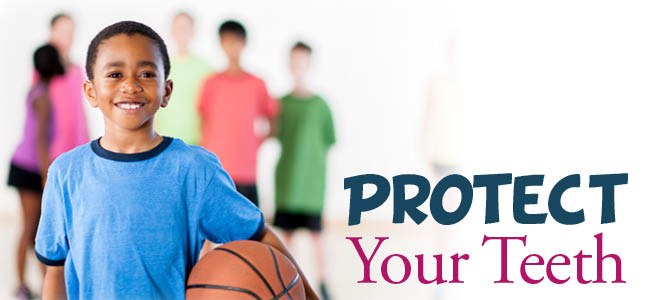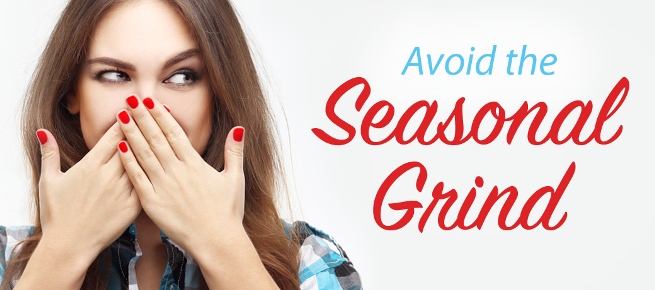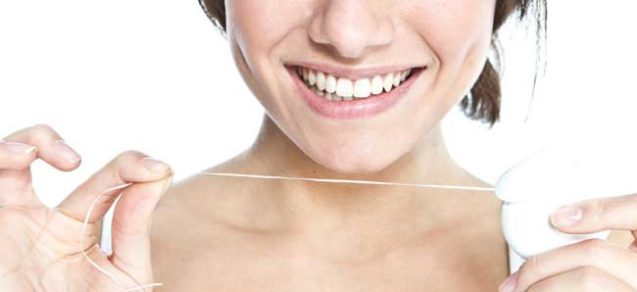By admin
01 Nov, 2016
Dental Health, Dental Tips, General Dentistry, General Health, Lifestyle, Oral Health, Preventive Dental Care
flossing, flossing alternatives, interdental brushes, waterpik
Flossing: In or Out?
It’s been six months since your last teeth cleaning. You arrive at your appointment and get called to head to the back by your hygienist. As she begins cleaning your teeth, she asks the question we all dread. “How often do you floss?” If you’re like many people, you might stretch the truth, or justify telling a white lie since you DID use a toothpick after dinner a few nights back.
Maybe now—lucky you!–you won’t have to answer that question any longer. Just recently the USDA and Department of Health and Human Services stated that flossing has been not been proven to be effective, and removed it from their dietary guidelines.
Well, slow down, my friend. You’re not off the hook just yet.
While this bold statement is technically true, there are still a few things to consider. First, the guidelines don’t say that flossing is bad or ineffective; they’re just saying there isn’t enough evidence in studies to prove it does help. The difference may feel like a matter of semantics, so for your own peace of mind, ask any dentist if you should floss. But you probably already know what their answer will be.
Your teeth consist of five surfaces, and brushing your teeth will hit all but two. Flossing will take care of the two remaining surfaces (the surfaces between your teeth) and ensure that plaque does not become tartar, which eats away at your teeth and gums. While flossing can help prevent tooth decay, a study by the Central for Disease Control shows that only 30% of the U.S. population flosses daily.
If you’re one of the 70% of people who don’t floss daily, you should know there are many alternatives to floss out there that can be just as effective in cleaning between your teeth.
Interdental Brushes – These are little brushes that you used to brush in between your teeth. People find these much easier to use than floss, and are good for people who have braces or larger gaps between their teeth.
Waterpik – The waterpik shoots a small, strong stream of water that can fit between small crevices in your teeth. It’s great to use for washing away plaque that can gather in pockets, but can take more time to master than floss or interdental brushes.
Floss Picks – A floss pick is a small piece of floss attached to a handle. These have become popular in recent times due to how convenient they are to use, but there are a few things to consider when using them. Since the floss is attached to a handle, manipulating the floss to hit all of the surfaces of your teeth can be difficult. Additionally, the recommended amount of floss to be used in a session is 12-18 inches, and the typical floss pick is only about two inches. Consider using more than one floss pick per session.
Regardless of what technique you use to clean between your teeth, the overall consensus is that anything is better than nothing.
Have a difficult time flossing every day? Start by doing it three times a week. Flossing takes time and doesn’t give immediate results, but think of it as an investment in your mouth’s future.
If you have any concerns about flossing, reach out to your Lancaster, CA dentist today. Just think about how good it will feel to tell your dentist and hygienist that you’ve been consistently cleaning in between your teeth!
More
By admin
02 Mar, 2016
Dental Emergency, Dental Health, Dental Tips, General Dentistry, General Health, Lifestyle, Preventive Dental Care
broken tooth, dental emergency, dental injury, dental trauma, knocked out teeth, mouthguards

The madness of March is right around the corner, and 68 NCAA Division I basketball teams will go head to head over the course of three weeks to determine the national champion — and you know what that means: excitement, upsets, and kids and adults alike heading out to have fun on the courts themselves.
Getting involved in any athletic activity is a great way to stay fit and healthy. Whether you are 8 or 58, sports offer an excellent form of active entertainment and exercise, but they also pose a threat to your oral health.
What the Stats Say
According to a new study*, playing sports comes with the heightened risk of dental and orofacial injuries:
- Each year more than 5 million teeth are knocked out of their sockets as a result of trauma.
- Basketball, football, hockey, martial arts, and boxing have the highest tooth-injury risk.
- Soft-tissue lacerations are the most common mouth and face injuries that occur during sports activities.
- Dental trauma can include tooth fracture, tooth loss, or injury resulting in a loose tooth.
Protect Your Teeth with a Mouthguard
The added risk to your dental health doesn’t mean you or your loved ones should shy away from playing sports. There are protective measures you can take to dramatically reduce the chances of damaging your teeth. The American Academy of Pediatric Dentistry (AAPD) recommends a mouthguard for all children and youth participating in any organized sports activities, including the following:
- Acrobatics
- Basketball
- Boxing
- Extreme
- Rugby
- Skateboarding
- Soccer
This recommendation is suitable for adults as well. In fact, according to the ADA, sports mouthguards have been shown to reduce the risk of sports-related dental injuries. Statistics show* that the overall rate of an orofacial injury is 1.6 to 1.9 times higher when a mouthguard is not worn. And while basketball and baseball are two sports in which dental and facial trauma are relatively common, participants rarely wear protection. Fortunately, famous athletes like Stephen Curry and LeBron James are great examples of athletes who are rocking mouthguards and killing it on the court.
So before you test your skills on the court, consider the example they have set. Having a dental provider fit you with a mouthguard that is resilient, comfortable, and durable could mean the difference between keeping or losing your teeth in a sports-related incident.
To find out more about mouthguards, call your Lancaster dental office at (661) 952-7865 to talk to a provider today!
*Young, E., Macias, R., Stephens, L. Common Dental Injury Management in Athletes. Sports Health: A Multidisciplinary Approach. 2013;20(10):1-6.
More
By admin
02 Dec, 2015
Dental Health, Preventive Dental Care
charity, floss, gifts, holidays, mouth rinse, oral health, oral hygiene, toothbrush, toothpaste

The holiday season is often touted as “the best time of the year!” While this is true for many, for some it can be the most difficult. For individuals and families coping with homelessness, in crisis, or dealing with a time of personal hardship, this time of year can be intensely challenging to face and even harder get through. When basic needs aren’t being met, the gift-giving season can take a toll. So during this season of abundance, consider giving someone less fortunate their smile back.
Toothbrushes, toothpaste, floss, and mouth rinse are everyday items that are often taken for granted. But these items enable people to enjoy one of the greatest gifts of all: a healthy smile. During difficult times, the smallest acts of kindness can mean the world for those in need. This season consider donating these basic tools for maintaining oral health and hygiene to a charity that supports those in need. If you aren’t sure where to start, consider some of the options listed below.
Donations for the Homeless
According to the National Alliance to End Homelessness, in January 2014 there were 578,424 people experiencing homelessness. This number includes families with children and individuals. National charities, like Catholic Charities, support the homeless, have a home base in most cities, and often take donations throughout the year and over the holidays. Most local homeless shelters also take donations and are in desperate need of oral hygiene products as well. Neighborhood churches put an extra effort toward making sure that everyone stays warm and cozy, and that everyone feels the spirit of community during the winter months. They are a great point of contact for your donation.
Domestic Violence Shelters
Somewhere between 2 million and 4 million women are victims of domestic violence each year. Many of them have children, and they may have little time to gather personal items before fleeing their abusers. They come to shelters without their clothing or personal supplies. Shelters are always looking for hygiene supplies and personal care products, especially around the holidays. Dental hygiene care pages that include child-friendly toothpastes, rinses, and brushes are appreciated and put to good use.
Ronald McDonald House Charities
Ronald McDonald House Charities provide a home-away-from-home for families of seriously ill children. The houses run year-round and offer a place for parents and family members to stay so that they can be close to their children while getting a break from the hospital atmosphere. They have many of the same comforts as home, including hot showers, laundry facilities, snacks, Internet access, and television. The Ronald McDonald House wish list includes individually packaged toothbrushes and toothpaste — a simple way to encourage a smile.
Budgets run tight during this season of giving. Oftentimes the idea of charitable giving can feel out of reach for many of us. It’s important to remember that something as small as a toothbrush can make all the difference in the world for those facing hardship. Every thoughtful act that comes from the heart ends in a smile.
Contact your Lancaster dentist Dr. Douglas Weber at (661) 952-7865 to find out more about how you can give members of our community the gift of a smile this holiday season!
More
By admin
30 Nov, 2015
Dental Discomfort, Dental Tips, General Dentistry, Lifestyle, Preventive Dental Care
bruxism, clenching teeth, face pain, grinding teeth, grinding teeth due to stress, headache, jaw pain, mouth guards, tmj causes

Protect Your Teeth From Holiday Stress: Avoid the Seasonal Grind
The holiday season is a time of year that comes with many things: visits from loved ones, weekly parties, a multitude of shopping trips, long hours spent in the kitchen, and stress-induced bruxism. Stress isn’t always a bad thing; in fact it can even be good in small doses. It can spur excitement, joy, and eager anticipation, and it can even function as that extra bit of motivation that you need to get everything on your to-do list done. Even when the outcome of the stress you are experiencing is positive, the effects it has on you physically can be negative.
What Is Bruxism?
The gradual onset of mild to moderate head and neck aches, jaw pain, and sensitive teeth can signal that stress is beginning to take a toll and that you might be suffering from a condition called bruxism. Bruxism is a condition in which you clench and grind your teeth throughout the day and night. The clenching and grinding can become so hard and loud that it can be heard by partners and loved ones within the affected individual’s living space.
Some individuals only suffer from short bouts of bruxism. But if you begin to experience any of the following associated symptoms with regularity, you should call and set up an appointment with our provider immediately.
Signs and symptoms that indicate you could be suffering from bruxism include:
- Worn tooth enamel
- Face pain rooted at the jawline
- Earache-like pain
- Headache in the temple area
- Sores from chewing or biting the inside of your cheek
- Grinding teeth during sleeping hours
If left untreated, bruxism can lead to more serious conditions that may require extensive and expensive care to resolve. These conditions include:
Damaged teeth: Individuals who suffer from bruxism end up clenching and unclenching their teeth all throughout the night. The pressure they put on their jaws can equate to 250 pounds or more worth of force, which can cause extreme wear and tear on teeth. Tooth sensitivity is the least of the repercussions this type of pressure can have on oral health. Chipped, cracked, and severely worn teeth can result, requiring extensive restorative treatments.
TMJ: TMJ is disorder of the temporomandibular joints that causes pain in the jaw, head, and neck areas. It can cause the jaw muscles to spasm and make it difficult for sufferers to open and close their mouths normally. Treatments may include Botox injections, medications that relax muscles, and protective nighttime mouth guards.
Sleep disturbances: Bruxism ranks as the third most frequent abnormal sleep behavior. Some suffers become aware of their condition after seeking out help for severe sleep deprivation and exhaustion. They have no idea that they have been grinding their teeth at night, nor that it is the cause of their daytime drowsiness.
Who’s at Risk?
Risk factors that increase your likelihood of suffering from bruxism include:
- Age: Bruxism is most common in children but can extend into adulthood.
- Stress level: If you have a high level of stress or an increase in anxiety, you may begin to experience the signs of bruxism.
- Substance intake: Smoking tobacco, drinking caffeinated and alcoholic beverages, or taking medications that have stimulants in them may increase the risk of bruxism.
Diagnosing Bruxism
If your dentist suspects that you have bruxism, he or she will perform an exam and evaluate you for the following:
- Damage to your teeth, the bone that supports them, and the soft tissues inside your mouth
- Pain and tenderness in the jaw and mouth area
- Common dental abnormalities that are often indicators, like broken, worn-down, or missing teeth and poor tooth alignment
If you have signs of bruxism, our dentist may choose to look for changes that may have taken place over the course of your visits. Your exam may include x-rays and questionnaires.
Treatments
In the case of children affected by bruxism, treatment is rare. The majority of children age out of bruxism. Adults who grind their teeth enough to cause damage and inflict pain have treatment options that include dental protection devices, such as mouth guards and splints, and corrective dental treatment plans designed to align teeth properly. Realigning teeth may require braces and, in severe cases, oral surgery.
If stress is at the root of a patient’s bruxism condition, our dentist will refer them to a therapist that specializes in stress management and behavior therapy. In some cases, medications such as muscle relaxants may also be prescribed.
The holiday season is a time of year to be enjoyed. You don’t have to let the excitement and anticipation take an unpleasant toll. If you are experiencing any of the symptoms that may indicate you are suffering from bruxism, call Dr. Douglas Weber at (661) 952-7865 to schedule an appointment today.
More
By admin
22 Nov, 2015
Dental Tips, General Dentistry, Lifestyle, Preventive Dental Care
dental health, healthy fall foods, healthy pumpkin prepration, healthy recipe, holiday dental tips, oral health, oral health benefits of pumpkin

Dentists Say, “Back Away From the Spiced Latte! But the Pumpkin Can Stay.”
It probably comes as no surprise that the Pumpkin Spice Latte is Starbucks’ most popular seasonal drink of all time. Everything about the pumpkin’s color, aroma, and savory flavor screams fall. Every year coffee enthusiasts eagerly await the release of this highly anticipated beverage, then flock to the coffee shop as soon as it becomes available. At least that is how it has gone for the better part of the last 12 years, since its inception in 2003.
But the Pumpkin Spice Latte isn’t your average cup o’ joe. Recently, the beloved libation has come under fire for the large amount of calories (380) and sugar (50g) it contains. Health and fitness professionals are urging people to consume it like they would any other dessert: in moderation. And while most health professionals are worried about the damage the Pumpkin Spice Latte can do to people’s waistlines, dentists are more concerned with the impact it could have on their patients’ teeth.
The bad news is that any way you look at it, the amount of sugar in your beloved Pumpkin Spice Latte, along with the length of time you spend sipping it down, is a recipe for tooth decay. The good news is that you can still satisfy your autumnal craving for pumpkin goodness by preparing and consuming it in different, delicious, healthier ways — and actually improve your dental and overall health while doing it.
Health benefits related to consuming pumpkin are plentiful. This vitamin-packed fruit can please both your nutrition/fitness professional and your dentist by protecting your teeth and whole health. Pumpkin provides:
- Zinc: Zinc is your mouth’s best friend. It plays a key role in healing wounds, which does wonders for damaged soft tissues inside your mouth, or gums that are healing from gingivitis-induced bleeding. Zinc is also considered an anti-plaque agent and is added to toothpaste to prevent buildup.
- Vitamin A: Vitamin A aids in the flow of saliva, which is key for washing bacteria from the mouth. It also plays a key role in healing soft tissues.
- Vitamin C: Vitamin C is key for maintaining a healthy immune system and fighting off infections. It’s good for your mouth and your overall health.
- Magnesium: Magnesium and calcium work together to create strong, protective enamel that can resist decay. Without the proper amount of Magnesium in your diet, your enamel becomes soft and susceptible to cavities.
- Fiber: Pumpkins are packed with fiber, which is important for maintaining excellent overall health. Fiber helps with weight control, and fiber-rich foods help stimulate the flow of saliva (your best natural defense against tooth decay).
If you are looking for a way to get your pumpkin fix this season while keeping your teeth and physique fit, minimize or eliminate the sugar. Consider replacing your daily spiced latte with these healthy pumpkin preparations:
Pumpkin seeds: From the store or straight from the gourd, these baked snacks are packed with flavor and good-for-your-teeth vitamins. They are easy to prepare and pack for lunch or an in-between-meal snack.
Pumpkin smoothie: Incorporate canned pumpkin into your breakfast or workout smoothie. It pairs well with coconut milk and almond butter. Throw in some pumpkin spice and maple syrup and your morning meal will be transformed into a healthy liquid version of the traditional pumpkin pie.
Baked pumpkin: You can make a tasty meal out of pumpkin by simply baking it with cinnamon and adding a little bit of butter. Pumpkin works as the main course but is also perfect as a side dish.
Pumpkin seed oil: One easy way to enjoy the health benefits that pumpkin has to offer is by incorporating pumpkin seed oil into your cooking. It adds a nutty seasonal taste to whatever dish you are preparing and is perfect for keeping you in that seasonal holiday mood.
Being dedicated to your physical and dental health doesn’t mean swearing off the Pumpkin Spice Latte for good. It just means taming your daily addiction and satisfying your pumpkin craving with snacks and dishes that are low in sugar and high in vitamin-rich goodness.
Call our Lancaster, CA dental office today at (661) 952-7865 and check up on your oral health. This is the perfect time to talk to Dr. Douglas B. Weber to find out more about how you protect your oral health through the holiday season.
More





